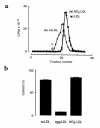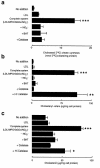Myeloperoxidase-generated reactive nitrogen species convert LDL into an atherogenic form in vitro
- PMID: 10359564
- PMCID: PMC408366
- DOI: 10.1172/JCI5549
Myeloperoxidase-generated reactive nitrogen species convert LDL into an atherogenic form in vitro
Abstract
Oxidized LDL is implicated in atherosclerosis; however, the pathways that convert LDL into an atherogenic form in vivo are not established. Production of reactive nitrogen species may be one important pathway, since LDL recovered from human atherosclerotic aorta is enriched in nitrotyrosine. We now report that reactive nitrogen species generated by the MPO-H2O2-NO2- system of monocytes convert LDL into a form (NO2-LDL) that is avidly taken up and degraded by macrophages, leading to massive cholesterol deposition and foam cell formation, essential steps in lesion development. Incubation of LDL with isolated MPO, an H2O2-generating system, and nitrite (NO2-)-- a major end-product of NO metabolism--resulted in nitration of apolipoprotein B 100 tyrosyl residues and initiation of LDL lipid peroxidation. The time course of LDL protein nitration and lipid peroxidation paralleled the acquisition of high-affinity, concentration-dependent, and saturable binding of NO2-LDL to human monocyte-derived macrophages and mouse peritoneal macrophages. LDL modification and conversion into a high-uptake form occurred in the absence of free metal ions, required NO2-, occurred at physiological levels of Cl-, and was inhibited by heme poisons, catalase, and BHT. Macrophage binding of NO2-LDL was specific and mediated by neither the LDL receptor nor the scavenger receptor class A type I. Exposure of macrophages to NO2-LDL promoted cholesteryl ester synthesis, intracellular cholesterol and cholesteryl ester accumulation, and foam cell formation. Collectively, these results identify MPO-generated reactive nitrogen species as a physiologically plausible pathway for converting LDL into an atherogenic form.
Figures













Similar articles
-
Macrophage scavenger receptor CD36 is the major receptor for LDL modified by monocyte-generated reactive nitrogen species.J Clin Invest. 2000 Apr;105(8):1095-108. doi: 10.1172/JCI8574. J Clin Invest. 2000. PMID: 10772654 Free PMC article.
-
Nitrogen dioxide radical generated by the myeloperoxidase-hydrogen peroxide-nitrite system promotes lipid peroxidation of low density lipoprotein.FEBS Lett. 1999 Jul 23;455(3):243-6. doi: 10.1016/s0014-5793(99)00893-5. FEBS Lett. 1999. PMID: 10437781
-
Formation of nitric oxide-derived oxidants by myeloperoxidase in monocytes: pathways for monocyte-mediated protein nitration and lipid peroxidation In vivo.Circ Res. 1999 Nov 12;85(10):950-8. doi: 10.1161/01.res.85.10.950. Circ Res. 1999. PMID: 10559142
-
Interaction of oxidized low density lipoprotein with macrophages in atherosclerosis, and the antiatherogenicity of antioxidants.Eur J Clin Chem Clin Biochem. 1996 Aug;34(8):599-608. Eur J Clin Chem Clin Biochem. 1996. PMID: 8877334 Review.
-
Atherogenic, dense low-density lipoproteins. Pathophysiology and new therapeutic approaches.Eur Heart J. 1998 Feb;19 Suppl A:A24-30. Eur Heart J. 1998. PMID: 9519339 Review.
Cited by
-
Plasma Membrane Localization of CD36 Requires Vimentin Phosphorylation; A Mechanism by Which Macrophage Vimentin Promotes Atherosclerosis.Front Cardiovasc Med. 2022 May 18;9:792717. doi: 10.3389/fcvm.2022.792717. eCollection 2022. Front Cardiovasc Med. 2022. PMID: 35656400 Free PMC article.
-
Two decades of vaccine development against atherosclerosis.Nano Today. 2023 Jun;50:101822. doi: 10.1016/j.nantod.2023.101822. Epub 2023 Mar 31. Nano Today. 2023. PMID: 37860053 Free PMC article.
-
Green tea extract protects against nonalcoholic steatohepatitis in ob/ob mice by decreasing oxidative and nitrative stress responses induced by proinflammatory enzymes.J Nutr Biochem. 2012 Apr;23(4):361-7. doi: 10.1016/j.jnutbio.2011.01.001. Epub 2011 May 2. J Nutr Biochem. 2012. PMID: 21543212 Free PMC article.
-
Oxidized phospholipids as endogenous pattern recognition ligands in innate immunity.J Biol Chem. 2008 Jun 6;283(23):15527-31. doi: 10.1074/jbc.R700054200. Epub 2008 Feb 19. J Biol Chem. 2008. PMID: 18285328 Free PMC article. Review. No abstract available.
-
CVD and Oxidative Stress.J Clin Med. 2017 Feb 20;6(2):22. doi: 10.3390/jcm6020022. J Clin Med. 2017. PMID: 28230726 Free PMC article. Review.
References
-
- Steinbrecher UP, Zhang HF, Lougheed M. Role of oxidatively modified LDL in atherosclerosis. Free Radic Biol Med. 1990;9:155–168. - PubMed
-
- Chisolm, G.M., and Penn, M.S. 1998. Oxidized lipoproteins and atherosclerosis. In Atherosclerosis and coronary artery disease. V. Fuster, R. Ross, and E. J. Topol, editors. Lippincott-Raven Publishers. Philadelphia, PA. 129–149.
-
- Berliner JA, et al. Atherosclerosis: basic mechanisms. Oxidation, inflammation, and genetics. Circulation. 1995;91:2488–2496. - PubMed
-
- Steinberg D. Lewis A. Conner Memorial Lecture. Oxidative modification of LDL and atherogenesis. Circulation. 1997;95:1062–1071. - PubMed
Publication types
MeSH terms
Substances
Grants and funding
LinkOut - more resources
Full Text Sources
Other Literature Sources
Medical
Research Materials
Miscellaneous

